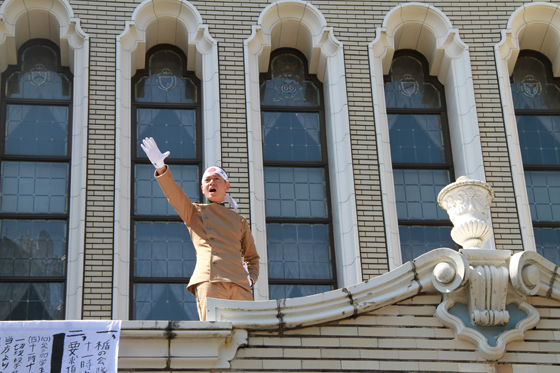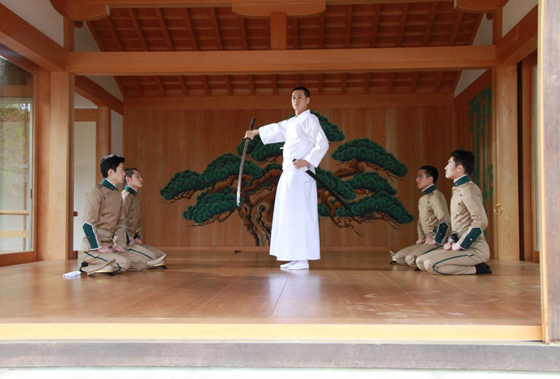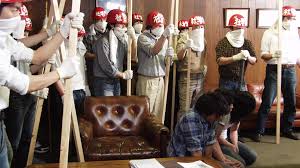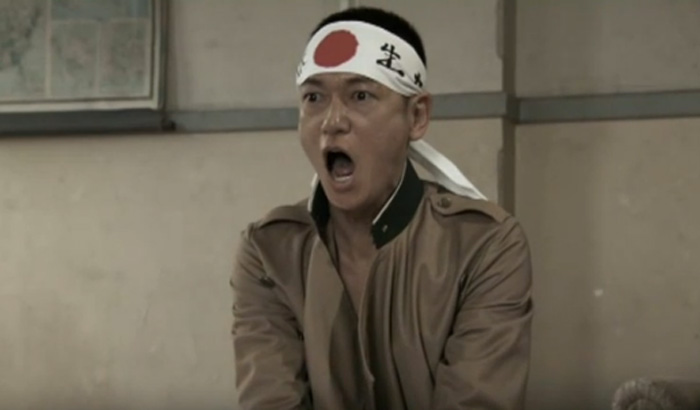 The Way Wakamatsu Chose His Own Fate
The Way Wakamatsu Chose His Own Fate
Political Mortality & Radical Dramaturgy
published in Senses Of Cinema No.65, Melbourne, 2012A 17 year old Japanese student is in his prison cell, preparing to hang himself. It’s 1960. A high pitched whine signals the slow emergence of the shō mouth organ as it brings to life the hive-like trailing of the ryuteki flute accompanied by solemn intermittent taps of the kakko and taiko drums. This gagaku traditional court music symbolises the ritual precision involved in the teenager’s suicide. An old man’s voice is heard off camera. His fevered pitch registers the shift from a passionate call to arms, to a rabid rant. He lists demands. He refutes compromise. As we watch the young student prepare his death, the subtitles translate this disembodied voice:
“...in my opinion, it's important to fix what's wrong so we can go back to our natural state. Regrettably this country is rife with the wrong, unjust and the unnatural.”
Then we see the man, speaking from a television broadcast. He’s in his 50s, wearing a suit and tie. He looks like he’s from the Taisho period—a brief moment in Japan’s history (1912-26) where things looked especially ‘Westernised’ according to a peculiar cosmopolitanism adopted by Japanese urban culture: trams, boater hats, pencil moustaches, flapper skirts. But combined with something traditionally Japanese: chrysanthemums, a yukata robe, getta sandals, a furoshiki carry cloth. Taisho is the liberal quiet during which dark clouds of Japanese militarism gathered. Our speaker is reading his declamations from a sheet he clutches. Off-camera and off-mic: a hub-bub of interjections yelled in a reverberant hall. This guy isn’t listening: he’s here to be heard. The subtitles continue:
“Article 9 of the Constitution prohibits the right of belligerency. A decision was made not to maintain any kind of armed forces and not to engage in any act of belligerency. But we have the Self-Defence Forces.”
The Japanese not too long before had listened to a different voice. The American Occupation (1945-1952) was inaugurated by the crackling radio voice of Emperor Hirohito renouncing his Sun God divinity. It marked a major shift in national consciousness as his broadcast voice rendered him—and Japan—mortal. Post-radio and post-Occupation, television came to Japan in 1953 as an audiovisual phoenix rising from the post-war ashes. Two subjects soon after made the new medium an oracle of national identity: the wedding of Emperor Akihito and Empress Michiko in 1959, and the massive victory of the wrestler Rikidōzan in the NWA International Heavyweight Championship in 1958. With the former, a floating procession of the betrothed couple (he, a blue-blood; she, a commoner) riding their horse-drawn carriage through the streets of Tokyo was enhanced by the glowing phosphoresence of the cathode ray tube. With the latter, a ritual of theatricalised power struggle was modernised to augur a reincarnated giant, whose glowing white torso was a talisman for Japan’s post-war recovery.
Along with refrigerators, television was a magic machine of industrial resourcefulness. No mere media marvel, its mass-production formed the post-war cornerstone for what would soon be proclaimed the denki electronics revolution. Japanese industry embraced its proliferation, understanding fully that recovery meant rejuvenation meant revolution. In a mirror maze of self-reflexivity, television also captured the squirming manifestations of revolution in the Diet. Our ranting man is one such example: we’re watching a live broadcast debate between the Liberal Democratic prime minister and his main rival from the Japanese Socialist Party. Before the safety-lag. Before programming. Before the news was televised. And then another subtitle line:
“The Security Treaty we ratified with America was also unconstitutional.”
He starts to declare something else, when suddenly a young man charges in from right of frame. Arms pulled across to his left side, he lunges straight into the heart of the speaker, wielding a dosu long knife. like a speeding car slamming into a brick wall, his body weight completely melds with the speaker’s contour. It happens in about a quarter of a second. They both shut their eyes on impact. The image freezes: the televised event is now a still image. You can study the conjoined terror and atomised confusion of this implosion. For some, the freeze-frame might appear to be a classic 60s film trope mimicking news photo-journalism, born of the pleading documentation of the Birmingham race riots [2], the Tet Offensive during the Vietnam War [3], or the Kent State University shooting [4]. It’s not. Because in the bluntest terms, this is not the USA: this is Japan. This is Japanese cinema. This is Wakamatsu Koji. And this is how he made movies.
* * *
Two things: dramaturgy and politics. First: dramaturgy, or how story is structured. In 11.25: The Day He Chose His Own Fate [1], this initializing moment of political terror is Japanese because of the rhythm of its dramaturgy. It sets in motion all that follows in the story—even if either the protagonists or the audience are unaware of its casual importance. It’s an opening event like the quicksilver slice of a samurai’s blade: the rest of the film is a corpse teetering, not knowing whether it’s alive or dead. The film’s prologue is its ending, its prescience of its mortality. The film unravels itself from this opening, trailing the seemingly isolated incident of the young right-wing extremist student Yamaguchi Otoya hanging himself after his assassination of Japanese Socialist Party politician Asanuma Inejrio during his live televised debate with the Liberal Democratic prime minister. In his cell, Yamaguchi had scrawled on the wall “Seven lives for my country. Banzai to the emperor!”. The film cuts from this desperate screed to Mishima Yukio checking the completion of his latest manuscript, the essay Patriotism (1961). Basically, the film tracks how this incident affected author Mishima. It charts his subtle descent from romantic historical novelist to active political advocate; from a dreamer of past glories to a believer in present changes. Yamaguchi’s act became Mishima’s ideal of poetry in action, of stating something few writers would dare: that the sword is as mighty as the pen (what Mishima referred to as the “harmony of the pen and the sword”).
But Wakamatsu delivers a tragic tale. His film ushers Mishima down a narrowing corridor of growing doubt and spreading ineffectiveness, portraying him cornered and frustrated. Mishima’s realization of his fate proceeds his disowning of writing as an act of relevance—politically, artistically, personally. His ritual suicide seemed irrefutable and inevitable. 11.25: The Day He Chose His Own Fate is not the day where he and his fellow Takenokai (Shield Society) stormed the Ground Self Defence Force headquarters and attempted their infamous coup d’état. It’s the day that Yamaguchi chose his own fate, committing suicide after killing Asanuma. Mishima’s life from that moment became—within Wakamatsu’s critical scope—a replay of Yamaguchi’s life and death. When he stands atop the Ground Self Defence Force headquarters roof unfurling his manifesto banners and throwing pamphlets down to the amassed soldiers, their raucous rebuttal of his posturing sounds exactly like the off-camera noise of protests dismissing Asanamu’s missives. Wakamatsu’s title is thus a cryptogram of fatalism, whose dramaturgy draws the figures of Yamaguchi and Mishima wedded by spiritual reincarnation—relating to Mishima’s notion of Japan being an abstracted spiritual essence rather than a concrete nation.
11.25: The Day He Chose His Own Fate accordingly adheres to a fatalistic logic. It enacts this by essentially dramatising a series of famous photographs. The procedure acknowledges the act of filmmaking not as being ‘storytelling’ but ‘story pre-told’. Photographs already mark the moment at which decisions have been made and actions taken; a film can but merely follow what has occurred. Wakamatsu crucially transforms a live televised event into a ‘still’ by the afore-mentioned freeze-frame. Its violence lies in its abrupt halt, its clinical glare, its explosive inaction. While the Western world is unlikely to be familiar with the televised debate, they certainly would be aware of the photograph taken by Nagayo Yasushi. Working for the Mainichi Shimbun daily newspaper in Tokyo, he snapped the moment when Yamaguchi performed his second stabbing of Asanuma. Nagayo won the 1961 Pulitzer Prize for the photo; it was featured in Life magazine that year. Global media mythology has enshrined it in accordance with all such photos of high impact gravity. But Wakamatsu shows us the first stab, after which Yamaguchi retracts his dosu and rams it again into the stumbling Asanuma as officials scamper towards him. Wakamatsu stops everything after that first stab, for that is the moment when change occurs. Like the announced name, the uttered sentence, the unscrolled letter, the revealed harmon crest, life in Japan changes drastically in the nanosecond of an eventful action. This is what attracts Wakamatsu. This is how Japanese narrative is configured. This is how Mishima’s fate was chosen.
* * *
Second, politics, or how story is impelled. Every sentence that had raged from Asanuma’s mouth constitutes a political equation of Eisensteinian causality, Zen-like consequence and extremist advocacy. His compressed point-forms are like constellations mapped upon Japan’s emergent position between the USA and China, between Western allies and Eastern brethren. Each spluttered claim tersely addresses the socio-political complexity in which Japan was embroiled not simply after the War, (or even—more dramatically—after Hiroshima and Nagasaki) but more so how Japan was loosened from the American Occupation into an elasticised straight-jacket within which it has constitutionally squirmed ever since.
It’s neither a simple nor familiar binary based on orthodox Cold War rhetoric. Japan’s standing between communism and capitalism is matricular not linear. Its national psyche is arguably a meld wherein nationhood is mysticised, race is intensified, and government is fantasised—in that order. The televised debate of 1960 demonstrated how nationhood/race/government could be discussed from this platform of common experience, after which deviation and conflict could be articulated. Both ‘sides’ of this debate shared deep criticisms of the Japan-US Joint Security Treaty. Both ‘sides’ harboured quasi-isolationist policies in order to strengthen Japan and return it to its former glory. The ‘debate’ occurred within the theatrical setting of democratic exchange, possibly as a concession to how Japan might modernise itself according to new post-war modes of international conduct. Yet numerous factions and streams within Japan were still registering complex heated feelings of nationhood following the seven years of the American Occupation and its consequent impact upon the newly drafted Japanese Constitution. The off-camera/off-mic noise we hear is the foment of that bubbling discontent. The on-screen stabbing is its eruption into the political arena. This lost archival footage — rarely seen outside of Japan — is a day in the life of an unheard Japan.
When the dosu penetrates the body/corpse of the Socialist politician, the body of Japan is ruptured anew. No wonder Mishima was inspired by the event: it rendered Japan as a bodily synecdoche, wherein Asanuma’s body needed to be extinguished for the body of Japan to be reborn. When Wakamatsu freezes the frame, he marks the moment of this rebirth. The faces of Asanuma and Kawaguchi are agents for this new procreative force, and the frozen image becomes an analytical diagram of cosmological devastation leading to a new Japan. Ideologically, the Western world—with Japan itself admonishing its own extremist parties—attempted to neuter any phoenix arising from these televisual ashes. Radical terrorism was deplored, democratic exchange was lionised, and the right for sides to forge opposing views peacefully was defended by countries around the world following the incident.
But this is precisely where Wakamatsu’s radical voice resonates. Despite being aligned with the Red Army Faction, he listens to a far right national extremist like Mishima in order to reflect upon how the agency for change necessitates extreme measures irrespective of their orientation. 11.25: The Day He Chose His Own Fate is periodically interrupted with amazing archival news footage and print copy rarely seen outside of Japan. A fascinating section captures the 1966 student protests organised by the United University Front at Waseda University which lasted for 150 days. Two years before the international fervour which inflamed the counter culture following the May ’68 barricades in Paris, the footage shows thousands of students protesting increases in fees. Later in the film, we see footage of the later-60s anti-Vietnam demonstrations strategically aimed to impair the Japan Rail’s Yamanote line which went through Shinjuku Station. To halt movement in a congested metropolis like Tokyo is the most powerful way to impact life, as it upsets the marvellous yet precarious balance of social exchange of ‘just-in-time’ industriousness upon which much of Japan’s economy is built. This is also another symbolic function of Wakamatsu’s employment of the freeze-frame.
Equally symbolic is Wakamatsu’s bracketing of Mishima’s political delusions between the most famous student protests against the Japan-US Joint Security Treaty, one in 1960, and a clutch of riots between 1969 and 1970 in Shinjuku protesting equally against the Treaty, the American presence in Okinawa, and Japan’s implicated support of the war in Vietnam. The former coincides with Mishima’s rebirth as a political agitator; the latter marks his political failure and consequent suicide. Wakamatsu uses documentation of leftist social forces to rage as deafening waves unheard by Mishima. And just as the student radical Yamaguchi surely must have identified with the intensity of nationalism Asanuma espoused, there was enough conflict of opinion to spur his radical action. Similarly, Wakamatsu has never demonstrated any nationalist leanings in the line of Mishima’s romantic revisionism, but both share a distaste for the rise of the “powerful police bureaucracy” Mishima bemoans—he due to them preventing the JSDP from cracking down on the student radicals; Wakamatsu for them doing the crackdown themselves. Later in the film, Wakamatsu uses footage of the late October 1967 protest against the Japanese prime minister Sato Eisaku’s visit to Vietnam, plus the ensuing riots in the following fortnight which saw the police arrest 2,092 protestors. Finally, Mishima reads about the Red Army’s infamous hi-jacking of a JAL plane in March 1970. He curses himself: “We’re late again.” In cross-connecting political points of view and allowing their conflicts to contribute to an ideological dissection of the situation, Wakamatsu’s film about Mishima allows him to forward a most complex political assessment of radical praxis irrespective of its binary orientation. Mishima declares the following in a way that seems to come from the mouth of Wakamatsu:
“Only living swords will deliver us from the intellectuals’ hypocrisy that’s plagued the nation since the Security Treaty was ratified in 1960.”
* * *
In some respects, 11.25: The Day He Chose His Own Fate remakes Misumi Kenji’s Ken (1964), based on Mishima’s novel of 1963. That film tells the story of a student youth leader, Jiro, who takes a group on a kendo training camp one sweltering summer to a small coastal village in the Izu Peninsula of Japan. Jiro inspires the students, is well-respected, and generally appears to be a righteous student if over-zealous. But inside he boils with unrepentant rage, tearing himself apart for not achieving his full potential as a young man in a new Japan. This manifests in his rigid and uncompromising views of student responsibility to kendo. Not surprisingly, Jiro is a figurine created by Mishima in his own image. He espouses the traditional mind-body fusion which Mishima supported, and the film’s numerous scenes of kendo competitions are imbued with a distinctively ascetic homo-eroticism beloved by Mishima.
Staring at the sun becomes a symbolic meme throughout the film. The Japanese flag is generally regarded as bearing the sun—the national ‘symbol’ of Japan—but the red dot on the white flag is actually an image in negative. It is more properly the sun as seen by one who stares into it, and has a sunspot burnt into his retina as a negative after-image. It’s a poetic reversal from the objective to the subjective, from the sun as thing you see to the sun as affect upon you. Throughout Ken, Jiro stares at the sun to blind himself with the power of Japan. He inflicts himself with Japanese-ness, torturing himself for his insufficient Japanese-ness. The camera lens flares at the opening of the film, blinding the audience with this subjective Japanese-ness, granting us a sense of nationalist illumination and searing existentialism.
Like 11.25: The Day He Chose His Own Fate, Ken is a tragic story. In a moment of leniency, Jiro accepts the growing criticism from his colleagues and charges that he’s being too harsh and restrictive in his training. The students have been sweating all week, running cross-country through the coastal village; on Saturday night they demand to be allowed to stay up and drink. But the next morning they sleep in and are late in meeting the school elders when they arrive. Mortified, Jiro commits suicide, shamed beyond ability to continue living. Ken was made only four years after the Asanuma assassination. The character of Jiro is a haunting dimensional figure, channelling the dead student Yamaguchi as well as the soon to be similarly dead Mishima, who committed ritual hara-kiri suicide in 1970. Wakamatsu’s film similarly channels Mishima, and presents him as a cypher of how Mishima imagined himself and how Misumi generated a figurine of the character Jiro. In a dizzy textual convolution, a politicised reincarnation is struck by Wakamatsu through this channelling. It’s something that goes well beyond the Western binary notion of politics and its limited ‘us-versus-them’ ideological barracking. In place, we have a dimensional, transformative and transcendental form of political articulation.
* * *
11.25: The Day He Chose His Own Fate might not be the best film to end Wakamatsu’s career. He died in late 2012 after being run over by a taxi cab in Tokyo. Some might prefer the equally fascinating yet comparatively linear film United Red Army (2009). It shines a harsh lens on the psychological realities which beset members of the RAF and the RLF in their attempt to unite in radicalism to overthrow Japanese mainstream society. Ultimately they imploded their political energy amongst themselves in a nihilistic frenzy of self-analysis and communal decimation. But 11.25: The Day He Chose His Own Fate is arguably a more compacted and anti-linear excavation of the terrorist mindset. Technically, Wakamatsu’s last film was also released the same year as his death: The Millennial Rapture, a story about a cursed blood line of womanizing Burakumin men living out their hedonistic but fatalistic generations in a remote village in the 1920s. Like 11.25: The Day He Chose His Own Fate, it’s a low-budget video production, with limited visual style, muted audiovisual impact, and a generally under-polished amateur veneer. In fact, it is hard to make a case for any of Wakamatsu’s later films as cinematic gems deserving auteur accolades. But 11.25: The Day He Chose His Own Fate eschews axiomatic models of ‘quality aesthetic cinema’: Wakamatsu is not necessarily a fitting model for international art house auteurism. The undeniable lack of audiovisual cinematic crafting in the film is a coded sign to consider the film under different terms. Wakamatsu’s films have always generated a strange sense that they are hovering somewhere else, away from an audience’s engagement with its stories. That place is the political netherland of imploding politics: a near-Godardian praxis of how sounds and images can interrogate and be interrogated, and how they implicate themselves devoid of either consensual authorship or audience desire.
In the case of 11.25: The Day He Chose His Own Fate, it means the film presents itself as an interrogation of how Mishima himself constructed his own ‘netherland of imploding politics’. Wakamatsu is careful to hardly show a moment where Mishima is engaged in writing. In the decade between the Asanuma assassination and his suicide, Mishima wrote sixteen novels, twenty short stories, and eight plays. Yet the film depicts how Mishima wasn’t a writer: how he desired something else and to be something else. Wakamatsu focuses instead on how Mishima imagined himself—from his identification with the televised debate to his controlled direction of his own image-making (hence the film’s deliberate quotation of the posed portraits he commissioned of his Storm Shield group, plus the photographs of him atop the building at his attempted coup d’état), to his delirious enrolment in the Ground Self Defence Forces to undergo their rigorous military training. Most tragically, the film depicts the ‘delusional praxis’ [5] of Mishima’s distribution of leaflets from atop the GSDF building and his inane yelling out to the gathered soldiers below who likely couldn’t have heard a single word he said. This is how ‘the political message’ gets swept away in the wind. This is the voice at its most withered, its most constrained, its most ineffectual. Wakamatsu plays the scene out to drain it of all drama: it’s a powerful scene of dramatic lack. One wonders if Mishima was putting into practice the true notion of a ‘suicidal performance’: he spent more time preening himself in uniforms than he checked on how far his vocals could carry.
In the final assessment, 11.25: The Day He Chose His Own Fate is a fascinating treatise against literature, testifying in place to the commitment Mishima held to the sublimity of failure—just like that expressed by the fictional student Jiro who was inspired by the actual student Yamaguchi. At a pivotal moment in the film, Mishima declares: “Death is culture”. One senses in Wakamatsu a deep understanding of this dark and ill-defined realm of failure (something that continues to make Godard’s films so fascinating) and how it generates a through-line by which few directors would consistently orient their art. Wakamatsu’s cinema has continually addressed the questionable efficacy of communicated discourse in the heat of agitational calls for change [6]. This is how he understands Mishima, with no recourse to romantic contextualization. And this is how 11.25: The Day He Chose His Own Fate expresses the way that Wakamatsu chose his own fate—his way of making cinema.
Thanks to Tetsuro Shimauchi and Rosemary Dean of Dean-Shimauchi, subtitlers of the film.
Notes
1. The original Japanese title references Mishima directly. The full translation of the film title is 11.25: The Day He Chose His Own Fate – Yukio Mishima and his Young Followers.
2. Life Magazine 11 page photo spread by Charles Moore in 1963 of the Birmingham police firing hoses and releasing dogs on the Children’s Crusade protests during the Civil Rights Movement’s Birmingham Campaign.
3. Pulitzer Prize for Photography for Eddie Adams in 1968 for his photo of General Nguyễn Ngọc Loan executing Vietcong prisoner Nguyễn Văn Lém on the street in Saigon.
4. Pulitzer Prize for Photography for John Paul Filo in 1970 of teenager Mary Ann Vecchio kneeling over the body of Jeffrey Miller after he was shot by the Ohio National Guard during the Kent State student protests against the Vietnam war.
5. See my Delusional Praxis and Cinematic Immolation in Ecstasy of Angels, UN Magazine, Vol.3 No.2, Melbourne, 2009.
6. The end theme ‘Only You’ written by Rurai Meehan and performed by BELAKISS poeticises this perspective:
“Only you – read between the lines.
Only you – should run away, and not hide.
Only you – stumble blind and follow.
Where you’re heading in this life – I don't know.”
Text © Philip Brophy. Images © respective copyright holders.












